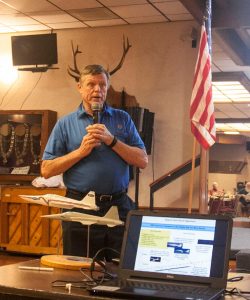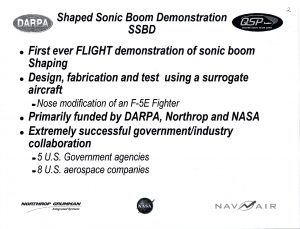 Gramps was pleased to hear from Col. Roy Martin USAF Ret. about research on how to fly supersonic without making the usual level of sonic boom. The program was titled SSBD, Shaped Sonic Boom Demonstration. This was a program funded by Northrup, NASA, and DARPA, the Defense Advanced Research Projects Agency, the same agency that was involved in the development of the internet. The program involved changing the shape of that part of the aircraft that encountered the hypersonic oncoming air. It is a study of CFD, Computational Fluid Dynamics, and was accomplished using a previously retired F-5E fighter aircraft. It involves the use of computer observation of airflow that took three days to fully analyze the results of study flights.
Gramps was pleased to hear from Col. Roy Martin USAF Ret. about research on how to fly supersonic without making the usual level of sonic boom. The program was titled SSBD, Shaped Sonic Boom Demonstration. This was a program funded by Northrup, NASA, and DARPA, the Defense Advanced Research Projects Agency, the same agency that was involved in the development of the internet. The program involved changing the shape of that part of the aircraft that encountered the hypersonic oncoming air. It is a study of CFD, Computational Fluid Dynamics, and was accomplished using a previously retired F-5E fighter aircraft. It involves the use of computer observation of airflow that took three days to fully analyze the results of study flights.
The F-5E fighter was used by the Navy to train pilots flying the current F-18s in air-to-air combat. The F-5E has a 10,000 hour limit on it before it is grounded but the Navy allowed the use of one of their nearly expired aircraft due for the Boneyard for 50 hours for this project. The project removed the nose and created a different shaped nose for the F-5E. The first flight was in St. Augustine, Florida. Ground based microphones were set up along the test path but unfortunately the local rats ate the insulation off the wires.
 Later 21 successful flights were accomplished in 90 days. The test A/C had had some of the electronic equipment removed so a handheld GPS was used. Yellow heat sensor tags were placed on the fuselage to record skin heat levels reached during flight. The first test flight attained 1.4 Mach or 1100 mph at an altitude of 32,000 feet. Subsequent flights were slower, reaching only 1.37 Mach due to the high temperatures in the area. The research also included wind tunnel testing. Four of the flights were conducted with an F-15 probe aircraft while 13 were conducted with a glider escort. The results were very useful. It was demonstrated that reshaping an aircraft’s fuselage can reduce the sonic boom. It was also shown that an aircraft’s sonic boom signature on the ground can be predicted. All of these things will be exceedingly useful to those companies producing high speed aircraft in the future.
Later 21 successful flights were accomplished in 90 days. The test A/C had had some of the electronic equipment removed so a handheld GPS was used. Yellow heat sensor tags were placed on the fuselage to record skin heat levels reached during flight. The first test flight attained 1.4 Mach or 1100 mph at an altitude of 32,000 feet. Subsequent flights were slower, reaching only 1.37 Mach due to the high temperatures in the area. The research also included wind tunnel testing. Four of the flights were conducted with an F-15 probe aircraft while 13 were conducted with a glider escort. The results were very useful. It was demonstrated that reshaping an aircraft’s fuselage can reduce the sonic boom. It was also shown that an aircraft’s sonic boom signature on the ground can be predicted. All of these things will be exceedingly useful to those companies producing high speed aircraft in the future.
We are grateful to Col. Martin for the presentation of this important data as well as his extensive service in the military flying world.






